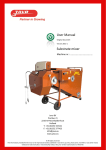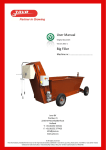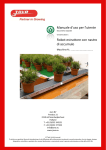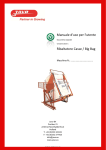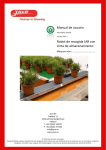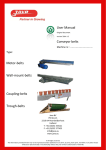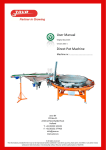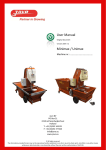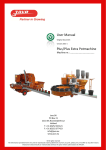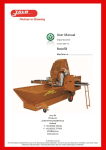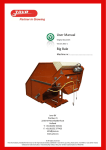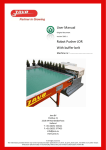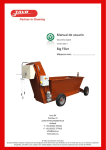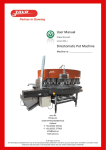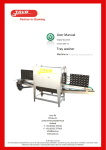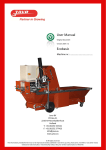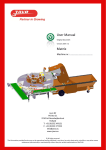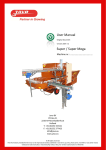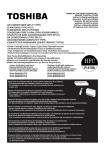Download User Manual Picking robot JAR with buffer belt
Transcript
User Manual Original document version 2015-1 Picking robot JAR with buffer belt Machine nr.: ………………………………… Javo BV PO Box 21 2210 AA Noordwijkerhout Holland T: +31 (0)252 343121 F: +31 (0)252 377423 [email protected] www.javo.eu © All rights reserved The information provided herein may not be reproduced and/or published in any form, by print, photo print, microfilm or any other means whatsoever (electronically or mechanically) without the prior written authorisation of JAVO BV. User Manual Javo JAR with buffer belt Preface This user manual is written for anyone working on or with the machine. Before working on or with the machine, first read this manual. This user manual contains important instructions / information on how to use the machine in a safe, professional and economical way and must always be available where the machine is used. In addition to this user manual, the mandatory rules and regulations for accident prevention and environmental protection in the country and place of use of the machine must also be observed. This user manual contains information on the operation of the machine with all the possible options. Use only the information that applies to your machine. Depending on the intensity of use and customer requirements, this machine can be equipped with various options. Contact your sales consultant. Supplier details if not directly supplied by Javo BV. Dealer stamp: Javo BV is not responsible for any errors in this manual or the consequences thereof. Javo BV is not liable for damage or consequential damage caused by operating errors, lack of expert maintenance and any use other than described in this manual. The liability of Javo BV also expires once modifications or additions are made without written permission of Javo BV. This machine is suitable for process and environmental conditions as stated in section "Specifications and Tolerances" of this manual. Any other use is not authorized by Javo BV and this allows the operator and / or its environment at risk. Version 2015-1 1 User Manual Javo JAR with buffer belt Table of contents 1 Technical specifications and tolerances ......................................................................................................... 3 1.1 2 3 Type plate.......................................................................................................................................................... 3 Safety ........................................................................................................................................................... 4 2.1 Provisions .......................................................................................................................................................... 4 2.2 Explanation of icons and symbols ..................................................................................................................... 5 Description of the machine ........................................................................................................................... 6 3.1 Machine overview ............................................................................................................................................ 6 3.2 Options .............................................................................................................................................................. 6 3.3 Operation .......................................................................................................................................................... 6 3.4 Machine workstations....................................................................................................................................... 6 3.5 Controls ............................................................................................................................................................. 7 4 Transport ..................................................................................................................................................... 8 5 Mounting, installation and commissioning .................................................................................................... 9 6 7 5.1 Placement ......................................................................................................................................................... 9 5.2 Facilities to take care of by the user ............................................................................................................... 9 5.3 Mounting / Connecting ..................................................................................................................................... 9 5.4 Check rotation direction ................................................................................................................................. 10 5.5 Check conveyor tension .................................................................................................................................. 10 Operation ................................................................................................................................................... 11 6.1 Start ................................................................................................................................................................. 11 6.2 In operation..................................................................................................................................................... 12 6.3 Stop ................................................................................................................................................................. 12 6.4 Emergency stop.............................................................................................................................................. 12 Maintenance .............................................................................................................................................. 13 7.1 Preventive Maintenance ................................................................................................................................. 13 7.2 Fault list ........................................................................................................................................................... 14 7.3 Drawings and schemes.................................................................................................................................... 15 7.4 Spare parts ...................................................................................................................................................... 15 7.5 JavoNet............................................................................................................................................................ 15 7.6 Customer support and advice ......................................................................................................................... 15 8 Disposal of machine or machine parts ......................................................................................................... 15 9 EG-conformity statement............................................................................................................................ 16 Version 2015-1 2 User Manual Javo JAR with buffer belt 1 Technical specifications and tolerances This machine is designed only to take away pots or trays with plants in rows of a buffer belt. Pots are put in blocks on the buffer belt. Then, the pots are conveyed forward to the end of the buffer belt, here the pots are pushed of the buffer belt onto a discharge conveyor per row. This is done with a belt driven unit. By setting the unit and the string with the correct speed the pots are moved smoothly on the conveyor. This machine is designed for the processing of pots and other materials described in this user manual. Detailed operation of the machine is described in section "Operation". This machine may be used only within the limits for specifications and tolerances of the order, on the assembly drawing and indicated in this manual. If the machine is used outside these specifications, Javo BV cannot take responsibility for this machine. This machine is intended for products as agreed in the order confirmation only. To ensure the proper operation of this machine, only products with specifications and tolerances as specified in the order may be used. Do not use the machine for purposes other than the intended purpose of Javo BV. This can lead to damage and danger to the operator and its environment. This machine is CE marked. When placing multiple machines in one line, the entire line must be properly CE marked before using this machine. Untill proper CE Marking of the line is carried out, commissioning of this machine is prohibited. Specifications Voltage Machine connection Power consumption Weight Length bandwidth overall width Height Belt material Fixed speed Variable speed Year of construction Type product * Other possible in consultation *400Volt 50Hz 3~+N+ PE 16A 5pole 3 KW ex. Buffer belt Depending on configuration of the buffer belt 2840, 3340, 5330, 5830, 6330, 7820, 8320, 8820, 9350, 10310, 10810 of 12310 mm 1600, 1800 of 2000 mm Size mentioned above + 187 mm 600-920 mm PU (smooth belt) Several delays possible inverter See type plate As agreed in the order confirmation. 1.1 Type plate The type plate is placed onto the main cabinet door. Version 2015-1 3 User Manual Javo JAR with buffer belt 2 Safety This machine is built according the state of the art technique and the accredited safety regulations. Despite this, the body and life from the user or third parties can be in danger when using it. There could also arise damage to the machine or other goods when using it. This machine is CE marked. When placing multiple machines in one line, the entire line must be properly CE marked before using this machine. Until proper CE Marking of the line is carried out, commissioning of this machine is prohibited. 2.1 Provisions 1. 2. 3. 4. 5. 6. 7. 8. 9. 10. 11. 12. 13. 14. 15. 16. 17. Operation and maintenance of this machine must be performed by qualified personnel in compliance with warnings on the machine and in accordance with the user manual. Keep children and other (unauthorized) persons away while using machine. This machine is suitable for process and environmental conditions as stated in section "Specifications and Tolerances" of this manual only. Any other use is not authorized by Javo BV and this allows the operator and / or the environment at risk. It is prohibited to modify this machine, without prior written approval of Javo BV. Thermal fuses and torque limiters may not be set different upon delivery of the new machine. The thermal circuit breakers should never be used to turn on / off the machine. This machine should be installed so that there is sufficient space remaining for providing safe instructions and / or performing maintenance and / or inspections. Put the brakes on the castors before the machine is turned on. Keep the work area clean and well lit. Cluttered or dark areas invite accidents. This machine is not suitable to be used outside. Electrical components are only splash proof. Keep the machine away from rain and moisture. When using the machine in a humid environment is unavoidable, you should use an RCD. Keep hands, hair, loose clothing and / or jewellery away from moving parts of the machine. Wear appropriate clothing without loose parts. Wear non-slip work shoes. As long as the machine is on, no connection or safety devices may be removed. The machine may only be used when all protective devices and safety-related facilities are available and ready for use. Do not stand on the machine when it is operating. Never move the machine if the power cable and / or pneumatic supply is still connected. Prescribed checks and maintenance in the user manual must be observed. Allow the machine to be serviced and repaired by qualified personnel only with original replacement parts. In addition to the user manual, generally applicable statutory and other regulations regarding accident prevention and environmental protection have to be respected. This is also referred to handling of personal protective equipment. Inform operating personnel before start maintenance. Interrupt if possible the power (mains), before start machine investigation or maintenance by turning off the main switch and locking the main switch. Pull the plug from the wall socket. a. As work must be done with power supply (mains) voltage on the machine, then arrange an additional person who can operate the emergency stop. When a machine part is damaged or not working in the prescribed manner, the work must be interrupted immediately. Resumption allowed only when the machine part is repaired or replaced and checked. Consult your dealer if the machine is not functioning properly. Machine and / or parts must be disposed in accordance with local laws and regulations. Version 2015-1 4 User Manual Javo JAR with buffer belt 2.2 Explanation of icons and symbols Pictogram Meaning Read and understand this manual before using the machine and / or performing maintenance. Remove Power (mains). Wear during all work on or with the machine safety shoes and safety glasses. Wear during cleaning and maintenance work on this machine also safety gloves and protective clothing. Warning. Important points and / or instructions regarding safety and / or injury prevention are marked with this warning sign. Dangerous electrical voltage. Dangerous electrical voltage present. Risk of crushing. Danger of moving or rotating parts. It is forbidden to wear Loose clothing, long hair and / or jewelry nearby moving parts of the machine. Trespassing. Do not rinse control cabinet Danger of moisture in the cabinet when it is rinsed with water. Symbols that may be present on this machine Drill Direction of movement Speed ground feeder (curved) Speed ground feeder (straight) Speed pot belt (curved) Speed pot belt (straight) Brush disc Rotofill Tray belt Rotofill Rotor Rotofill Version 2015-1 5 User Manual Javo JAR with buffer belt 3 Description of the machine 3.1 Machine overview 1. Buffer belt / Broad belt a. The Buffer belt is the belt that provides pots or trays to the discharge unit in a way that the discharge unit is able to move the pots or trays to the exit conveyor. 2. Discharge unit a. The discharge unit is the unit that takes over pots or trays from the buffer belt to the exit conveyor. 3. Exit conveyor a. The exit conveyor is the conveyor that moves pots or trays to the exit. 4. Contact plate (option) a. When trays are discharged, trays are pushed onto the exit conveyor by other trays on the buffer belt, up to the contact plate. 4 Contact plate 3.2 Options Depending on the intensity of use and customer requirements, this machine can be equipped with various options. Contact your sales consultant. Options Trays Code Specifications Without discharge unit, with contact plate 3.3 Operation This machine is designed only to take away pots or trays with plants in rows of a buffer belt. Pots are put in blocks on the buffer belt. Then, the pots are conveyed forward to the end of the buffer belt, here the pots are pushed of the buffer belt onto a discharge conveyor per row. This is done with a belt driven unit. By setting the unit and the string with the correct speed the pots are moved smoothly on the conveyor. When trays are discharged, they will be pushed by other trays on the conveyor up to the contact plate. The contact plate is provided with a sensor that detects the presence of trays. The last rows of trays are not always pushed because the trim is removed. A metal bar is available that can be placed on the buffer belt behind the last tray to create sufficient thrust. 3.4 Machine workstations There are no workplaces at this machine. Version 2015-1 6 User Manual Javo JAR with buffer belt 3.5 Controls Operation of the machine can be done by means of the pushbuttons that are mounted on the upper side of the control cabinet. 8 Wachten aanvoerband Operation of the buttons is described below: 1) Emergency stop button This button causes the machine to stop abruptly. Use it only in case Of emergency! (The machine has more than one emergency stop button, they are placed on the side of the buffer belt). 2) Reset emergency stop (blue) When the emergency has been active on the machine, the emergency stop relay (the relay which switches the machine safely) has to be reset, in order to ensure that the machine can safely start. 3) Start machine (green) This button allows the machine starts. This is allowed only if the emergency stop of the machine is not running and the emergency stop relay is reset. The LED in the button lights up when the machine is started and flashes if the machine is stopped by another machine (external stop). 4) Stop machine (red) This button causes the machine to stop. Use it when you are finished using the machine, or if there is a fault. The LED in the button lights up when the machine is stopped. Flashes, then there is a malfunction. (See section software) 5) Speed of movement discharge unit This rotary knob controls the speed at which the customer puts Sets the speed of the discharge unit. The speed can be controlled from a minimum of 10 Hertz up to 50 Hertz. 6) Variable speed belt take-off This knob controls the speed of the string. The speed can be controlled from a minimum of 10 Hertz up to 50 Hertz. 7) Speed of conveyor belt This knob controls the speed of the discharge conveyor. The speed can be controlled from a minimum of 10 Hertz up to 50 Hertz. 8) Waiting conveyor belt on / off Waiting with supplying plants until the conveyor is empty. Version 2015-1 7 User Manual Javo JAR with buffer belt 4 Transport Follow all instructions described in this manual, in particular chapter safety. On delivery of the machine, a Javo mechanical engineer must be present to unload the machine from the (freight) wagon. Prior to moving the machine, the electric, pneumatic and hydraulic power should be disconnected. Make sure the cables are stowed sufficiently. When moving within the company (when the machine does not need to be lifted) the state of the machine should be checked. Make sure the path to be travelled is free, so the machine can be moved to the desired position without obstacles. If the machine is to be lifted for movement (outside the company), please contact your dealer or contact a professional shipping company. Before the machine can be moved, the conveyor belt must be removed. The machine must be transported upright. The relative humidity should not be too high so that water condenses in the machine. Report damage during or immediately after delivery to the transport company and to Javo BV. Take all necessary steps to prevent further damage. Version 2015-1 8 User Manual Javo JAR with buffer belt 5 Mounting, installation and commissioning Follow all instructions described in this manual, in particular chapter safety. This machine is CE marked. When placing multiple machines in one line, the entire line must be properly CE marked before using this machine. Up to CE Marking of the line, commissioning of this machine is prohibited. 5.1 Placement The machine must be placed on a flat surface, with sufficient weight capacity. Install the machine so that there is enough space left for service providing, safe instructions and / or cleaning, maintenance and / or inspections. Put the brakes on the castors before the machine is turned on. This machine is not suitable to be used in the open air. Electrical components are only splashproof. Keep the machine away from rain and moisture. When using the machine in a humid location is unavoidable, you should use an RCD. 5.2 Facilities to take care of by the user Prior to delivery of the machine, the required materials and facilities (power, etc.) needs to be present within 3 meters of machine. Required power supply: 400 Volt, 3 Phase + Neutral + Earth. (N. America: 208/220V 60Hz.). 5.3 Mounting / Connecting If applicable, the components supplied are to be mounted on the machine. Make sure that the moving parts are free. If the machine is complete, it can be connected (by a competent person) to the power supply. Keep hands, hair, loose clothing and / or jewellery away from moving parts of the machine. Wear appropriate clothing without loose parts. Wear non-slip work shoes. As long as the machine is on, no connection or safety devices may be removed. The machine may only be used when all protective devices and safety-related facilities are available and ready for use. Version 2015-1 9 User Manual Javo JAR with buffer belt 5.4 Check rotation direction Check the rotation direction before you start working with the machine. Procedure: 1. Connect the power cable. 2. Start the conveyor. a. Turn on the main switch. 3. Check the direction of rotation. 4. Stop the machine. 5. Turn off the main switch. 6. When rotation direction is incorrect: a. Turn the reversing switch if this option is installed. Otherwise, follow points b and c. b. Remove the plug from the socket. c. Open the plug and switch 2 of the 3 phases in the plug. This should only be carried out by suitably qualified personnel. Note: All the conveyors with the exception of the trough-belts can work with both a pulling and with a pressing drive. With a pulling drive more weight can be moved and the belt will be less likely to slip. 5.5 Check conveyor tension Check the conveyor belt tension before you start working with the machine. Procedure: 1. Check the conveyor belt tension. The correct tension is obtained when the belt in the middle deflects just a little (dependent on the length of the belt). 2. Adjust the belt tension if necessary . a. The tension can be adjusted by simultaneously turning the bolts on both sides of the belt (A). Version 2015-1 A 10 User Manual Javo JAR with buffer belt 6 Operation Follow all instructions described in this manual, in particular chapter safety. Keep hands, hair, loose clothing and / or jewelry away from moving parts of the machine. Wear appropriate clothing without loose parts. Wear non-slip work shoes. As long as the machine is on, no connection or safety devices may be removed. The machine may only be used when all protective devices and safety-related facilities are available and ready for use. If a machine part is damaged or not working in the prescribed manner, work must be interrupted immediately. Resumption allowed only when the machine part is repaired or replaced and checked. Consult your dealer if the machine is not functioning properly. 6.1 Start Start procedure: 1. Switch on the main switch at the main cabinet. 2. Push the blue reset button. Make sure there is no danger when starting the machine. 3. Set Potentiometer “Snelheid beweging afnemer”, When setting for the first time: set the potentiometer to “0”. 4. Set Potentiometer “Snelheid snaar afnemer”, When setting for the first time: set the potentiometer to “0”. 5. Set Potentiometer “Snelheid afvoerband”, When setting for the first time: set the potentiometer to “0”. 6. Push the green button to start the machine. a. The light in the knob will lit when the machine is started. b. The buffer belt will start moving in the direction of the discharge. When moving into the wrong direction, see section 5.4. c. At the moment that a row is detected by the sensor, the discharge unit is started. Adjust Potentiometers “Snelheid beweging afnemer”, “Snelheid snaar afnemer” and “Snelheid afvoerband”. Adjust in such a way that pots or trays are discharged correctly to the exit conveyor. The settings can be different for potsizes and sorts of plants; there are no fixed settings. 8 Wachten aanvoerband Version 2015-1 11 User Manual Javo JAR with buffer belt 6.2 In operation 6.3 Stop Stop procedure: 1. Push the red stop button. 2. Switch off the main switch. 6.4 Emergency stop Emergency stop procedure: 1. Press the red emergency stop button on the machine to activate the emergency stop. Restart after emergency stop procedure: 1. Ensure that the cause of the emergency is resolved. 2. Pull the red emergency stop button to reset. 3. Press the reset button. 4. Press the green button on the control panel to start the machine. Version 2015-1 12 User Manual Javo JAR with buffer belt 7 Maintenance Follow all instructions described in this manual, in particular chapter safety. Maintenance of this machine must be performed in compliance with warnings on the machine and in accordance with the user manual by qualified personnel. Keep hands, hair, loose clothing and / or jewellery away from moving parts of the machine. Wear appropriate clothing without loose parts. Wear non-slip work shoes. As long as the machine is on, no connection or safety devices may be removed. The machine may only be used when all protective devices and safety-related facilities are available and ready for use. Always unplug the plug from the socket before starting maintenance. Wear personal protective equipment (see section 2.3). Inform operating personnel before start maintenance. Interrupt if possible the power (mains), before the machine is investigated or maintained by turning off the main switch and locking it and pull the plug from the socket. If work must be done with power supply (mains) voltage on the machine, work with an additional person who can operate the emergency stop. 7.1 Preventive Maintenance For the following maintenance instructions normal use is considered. With heavy use, or use under extreme conditions, maintenance should be performed at shorter intervals. Item 1x per... Belt Safety components Pictograms Electrical installation Electric motors Day Week Week Year Year Machine Version 2015-1 Day Comments Check if moving parts are functioning correctly and not clamping and / or parts are broken or damaged in such a way that the operation is adversely affected. Have damaged parts repaired before use. Check tension. See section “Mounting, installation and commissioning”. Test the safety circuit. See section “Test safety circuit”. Check readability and replace if necessary. Check for damage. Remove dust. 13 User Manual Javo JAR with buffer belt 7.2 Fault list Problem Motor fault Possible cause mains voltage deviates more than 10% of the rated motor voltage Too high cooling air temperature Poor cable connection Action / Solution Provide the correct voltage Provide cool air check the cable connection and repair if necessary Blown fuse Replace fuse Too little cooling air caused by a clogged cooling Ensure proper inlet and outlet of the cooling air air passage Red light flashes every 0,02 seconds. The discharge unit out of home position for too long. There is either a motor defect or a mechanical defect. The motor hums Defect winding and takes too much power Call a mechanic Repair or replace the motor winding Thermal fuses are Red light flashes every 0,2 seconds. Motor fault. Call a mechanic blown Motor is connected incorrectly Connect the motor correct Belt is not moving Pretension of the belt is too low (belt slips) Machine does not Emergency stop button not reset. Red light is lit start continuously Emergency stop button not reset. Red light is lit continuously Breaker tripped in main cabinet Adjust belt tension Pull Emergency Stop button and reset the safety circuit by pressing the reset button Reset the safety circuit by pressing the reset button See why circuit breaker has tripped. Remove obstacles to conveyors. Switch on the machine after solving the problem. Cable length too large causing voltage loss Reduce cable length Voltage fluctuations caused by other devices on Ensure the correct voltage. Turn off other the same group devices Red light flashes every 1,0 seconds, Green light Machine stopped externally. Clear the exit at flashes every 1,0 seconds. A second machine in the second machine in line. line is not ready and therefor the exit is not cleared. Red light flashes every 0,2 seconds. A plant fell Remove the plant in case the plant is blocking a over at the exit conveyor. sensor. Then restart the machine. Exit conveyor is Sensor at the exit conveyor is not detecting Adjust or replace the sensor. moving but JAR is anything. Sensor might be placed too far away. not moving or it takes too long Time for release is Potentiometer “0” (left) is set too high. Readjust potentiometer (rotate gently). too long Distance exit Potentiometer “1” (right) is set too high or too Readjust potentiometer (rotate gently). conveyor too long low. or too short Version 2015-1 14 User Manual Javo JAR with buffer belt 7.3 Drawings and schemes The drawings accompanying this machine are supplied in a separate file. The wiring diagrams are included in the electrical cabinet of the machine. 7.4 Spare parts Only original spare parts and accessories of Javo BV may be used on the machine. Javo BV advises you to take certain parts in stock because of wear sensitivity and / or any expected downtime for reordering of the parts. The spare parts list can be found on the assembly drawings. These can be found on JavoNet. When ordering (spare) parts at Javo BV, the following information must be included: drawing number, item number, desired length (if applicable) and the desired number of pieces. 7.5 JavoNet We recommend you to register your machine on JavoNet. This way you get online access to all technical drawings and documents pertaining to your machine. Visit our website (www.javo.eu) for more information and to request an account. 7.6 Customer support and advice Our technical department will answer your other questions about repair and maintenance of your machine and spare parts. We can help you with any questions regarding the purchase, use and settings of products and accessories. 8 Disposal of machine or machine parts Follow all instructions described in this manual, in particular chapter safety. Perform the following steps when disposing the machine: 1. Decommission the machine and remove electric and pneumatic power. 2. Drain and remove all consumables. 3. Scrap the machine according to the local legislation. Version 2015-1 15 User Manual Javo JAR with buffer belt 9 EG-conformity statement EG-conformity statement for machines (directive 2006/42/EG, annex II, under A.) Javo BV Westeinde 4 2211XP Noordwijkerhout The Netherlands Declares that: Machine: Type: JAR with buffer belt Transport system is in accordance with the Machine directive 2006/42/EG and complies with the provisions of the EMC-directive 2004/108/EEG Complies with the harmonized European Standards: Harmonized European standard NEN-EN-ISO 12100:2010 NEN-EN-IEC 60204-1 definition Safety of machinery - Basic concepts, general principles for design - Part 1: Basic terminology, methodology Safety of machinery - Electrical equipment of machines - Part 1: General requirements The Netherlands, Noordwijkerhout, March 2015 Version 2015-1 Harmonized European standard definition NPR-ISO/TR 141212:2010 Safety of machinery - Risk assessment - Part 2: Practical guidance and examples of methods Cees Bouwmeester Director 16


















